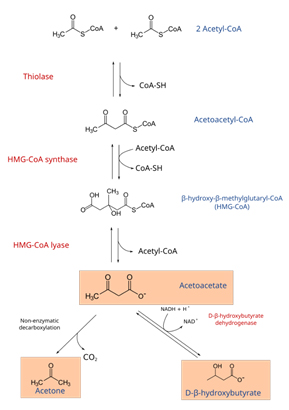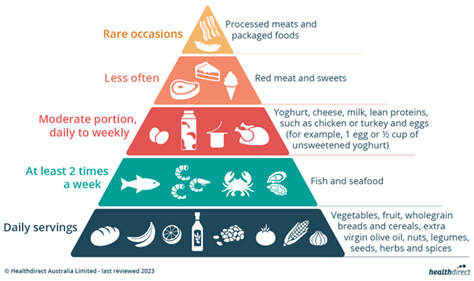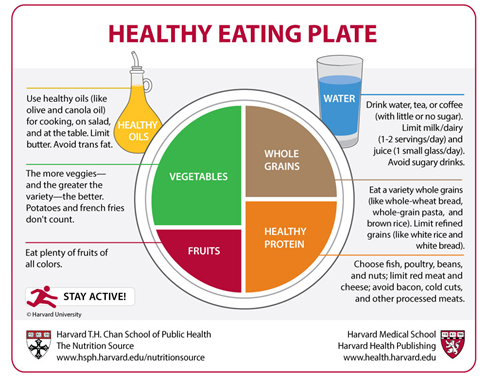Biochemistry in Health Diet for Weight Control
As you have learnt the importance of keeping a healthy weight from previous article, you may wonder what dietary approach is best for your weight control. There is no consensus on which weight loss program is the best. Before you choose a diet plan, you need to consider the following factors.
- Your health condition – If you have diabetes, heart disease or allergy, you should talk to your doctor whether the dietary plan is suitable for you.
- Avoid fad diets – If the diet requires you to take out an entire food group, there is a risk that you may suffer from nutrient deficiency. For those diets that promise a quick weight loss may not be healthy, and probably not sustainable.
What are the choices of weight loss diet?
Here are some common eating plans for weight control.
Energy restricted diet
The diet aims to decrease energy intake by 500 -750 Kcal per day1 based on energy expenditure of the individuals and this would translate into a weight reduction of around 2 kg per month. It is achieved by reducing the portion size of food to reduce the diet’s energy intensity. Once the energy intake is less than energy output, body weight will be reduced. The prescription follows the balanced profile of nutrients similar to the recommendations for general population. A systematic review of numerous studies showed that energy restricted diet, when combined with regular exercise, intake of high fiber food and avoidance of high calorie food, induced mean weight losses of 5-8 kg in 6 months.1 This approach is commonly prescribed by dietitians and healthcare professionals as a first line treatment for obesity and recommended by most dietary guidelines.
Intermittent Fasting
Intermittent fasting has recently become widely popular for managing obesity. It involves fasting and unrestricted eating periods. Different fasting techniques are depicted in table 1.
| Time restricted fasting (Fasting for a certain period in a day) |
16:8 Eating during 8-hr window, fasting for 16 hr 6:18 Eating during 6-hr window, fasting for 18 hr 4:22 Eating during 4-hr window, fasting for 20 hr |
| Complete alternate day fasting | Eating one day, fasting next day |
| Periodic fasting | 5:2 days Eating for 5 days, fasting for 2 days |
Intermittent fasting causes a change in hormonal secretions and metabolic pathways that leads to improvement in insulin sensitivity, blood pressure, blood glucose levels, lipid profile and inflammatory markers.2 A weight reduction of 4-10% over a period of 4-24 weeks was attained for individuals with overweight or obesity.2
However, clinical evidence on intermittent fasting is based on studies of small sample size and there is limited human studies to demonstrate its safety and long-term effectiveness.3 Side effects on hunger, fatigue, dizziness, digestive issues such as bloating and constipation have been reported. The fasting diet is NOT suitable for some groups of people including children, elderly, patients with chronic diseases such as diabetes, cardiovascular disease, kidney failure and cancer, people with compromised immune system and women who are pregnant or breastfeeding.
Low Carbohydrate Diet (LCD)
Low-carbohydrate diet (LCD) limits intake of carbohydrate and focuses on food high in protein or fat. The carbohydrate restriction is <130 g/day which is equivalent to <26% of total energy from carbohydrates.4 LCD avoids grains such as rice and oats, breads, noodles, starchy vegetables like potatoes and corns, fruits and sweets. It focuses on protein rich food like meat, poultry, fish, nuts; and fat from animal food. Non-starchy vegetables like broccoli and cabbage are allowed.
Under normal situation, glucose obtained from carbohydrate foods is the main source of energy in the body. When our body is deprived of glucose, ketones is produced from fat as an alternative energy fuel via the ketogenesis pathway (Figure 1). LCDs help to suppress appetite, induce fat oxidation (break down fatty acid to release energy) and rapid weight loss.2 LCD is potentially a very effective option for patients with diabetes and obesity as it improves triglyceride & HDL-C levels, glycaemic control & reduce diabetic medications.4

Figure 1 Ketogenesis pathway. Fatty acids are first broken down into acetyl-CoA in the liver. Two molecules of Acetyl-CoA will combine and follow a series of biochemical reactions to form ketones bodies. The 3 ketone bodies (acetoacetate, acetone, and beta-hydroxy-butyrate) are marked within orange boxes.
Very-low-carbohydrate diet (VLCD) or Keto diet
One of the most popular forms of LCDs is Very-low-carbohydrate diet (VLCD) or Keto diet. It is a very-low-carbohydrate, fat-rich diet with typical fat composition of 70-80%.1 Usually, intake of carbohydrate is kept at less than 50g/day which is equivalent to 1 bowl of rice or 2 pieces of medium sized apples a day. Keto diet is difficult to follow due to the strict restriction on carbohydrates.
Keto diet can reduce body weight in the short term (mean weight loss of 10kg in less than 4 weeks).1 But the effect is not significantly different after one year when compared with the effects of conventional weight loss diets. Adverse effects such as nausea, vomiting, fatigue, insomnia, and constipation are common. In fact, there are concerns5 of the Keto diet because of the lack of long-term studies to substantiate its benefits, and the increased risk of fatty liver, heart disease, kidney stones, vitamin and mineral deficiencies, muscle loss & cognitive decline. Keto diet is generally NOT recommended due to the associated health risks and it is not sustainable.
Mediterranean Diet (MedDiet)
MedDiet (Figure 2) is one of the mostly studied diet and well recognized for its beneficial health effects. It is a plant-based diet built around vegetables, fruits, herbs, nuts, beans and whole grains. The diet allows dairy, poultry, eggs and seafood in moderation. Red meat is eaten only occasionally. Olive oil is the principal source of fat. It limits the amount of food with added sugar and processed meat.

Figure 2 Mediterranean diet
Strong evidence from long-term studies and randomized trials demonstrated many health benefits of MedDiet including reductions of cardiovascular disease incidence and mortality, type 2 diabetes and metabolic syndrome, incidence of some cancers and cognitive function.6> Studies have shown that MedDiet produced similar weight loss as other diets like the low carbohydrate diet (4.1 to 10.1 kg vs 4.7 to 7.7 kg) after one year or more.6
The main mechanisms underlying the diet’s beneficial effects are probably due to decreased plasma lipid levels, alteration of hormones and growth factors implicated in carcinogenesis, protection against oxidative stress and modulation of gut microbiota composition.2
How to choose a healthy diet for me?
Each of the above dietary strategies has its benefits and drawbacks. If you are a diabetic or have cardiovascular disease, intermittent fasting is not suitable for you. Someone who are reluctant to keep track of calorie intake or portion size will find it difficult to follow energy restricted diet. Therefore, the decision criteria depend on your health status and adaptability to the diet.
As a rule of thumb, the eating habit and lifestyle that many people find healthy and effective for weight management share the following elements:
- Eat plenty of vegetables and fruits (aim for different colour and variety)
- Eat whole grains instead of refined grains
- Consume foods with high quality protein, high fiber content and good quality fat
- Avoid foods high in saturated and/or trans-fat, sugar or salt
- Limit red meat (beef, pork, lamb) and avoid processed food (e.g. ham, bacon, sausages)
- Keep alcohol less or in moderation
- Take regular exercise
A healthy eating plate (Figure 3) created by Harvard School of Public Health summarized the above key points help you to create a healthy and balanced meal in an easy way. It does not define the quantity of calories or servings per day as these numbers vary depending on the age, gender, body size and degree of activity of each individual. This healthy plate mainly aims to give you the proportion of each food group for healthy eating.

Figure 3 Healthy Eating Plate
Successful weight control requires a long-term commitment to healthy eating habit and lifestyle. You have to choose an approach that you can embrace for life. After reading this article, I hope you can identify the strategy to effectively manage your body weight and fostering overall health and well-being.
References
- Chao Ariana M., Quigley Kerry M., Wadden Thomas A. Dietary interventions for obesity: clinical and mechanistic findings. Journal of Clinical Investigation 2021;131(1):e140065.
- Hwalla N., Jaafar Z. Dietary Management of Obesity: A Review of the Evidence. Diagnostics 2021, 11,24.
- Patterson Ruth E., Laughlin Gail A., Sears Dorothy D., LaCroix Andrea Z., Marinac Catherine, Gallo Linda C., Hartman Sheri J., Natarajan Loki, Senger Carolyn M., Martínez María Elena, and Villaseñor Adriana. Intermittent Fasting and Human Metabolic Health. J Acad Nutr Diet. 2015 August ; 115(8): 1203–1212. doi:10.1016/j.jand.2015.02.018.
- Kelly Tara, Unwin David and Finucane Francis. International J Environmental Research & Public Health 2020, 17, 2557; doi:10.3390/ijerph17072557
- Masood Wajeed, Annamaraju Pavan, Suheb Mahammed Z. Khan, Uppaluri Kalyan R. Ketogenic Diet. StatPearls Publishing LLC. 2024 https://www.ncbi.nlm.nih.gov/books/NBK499830/
- Guasch-Ferre M, Willett WC. The Mediterranean diet and health: a comprehensive overview. Journal of Internal Medicine 2021; 290: 549–566.
By K.L. Tang, Nutritionist, HKBU chemistry alumnus